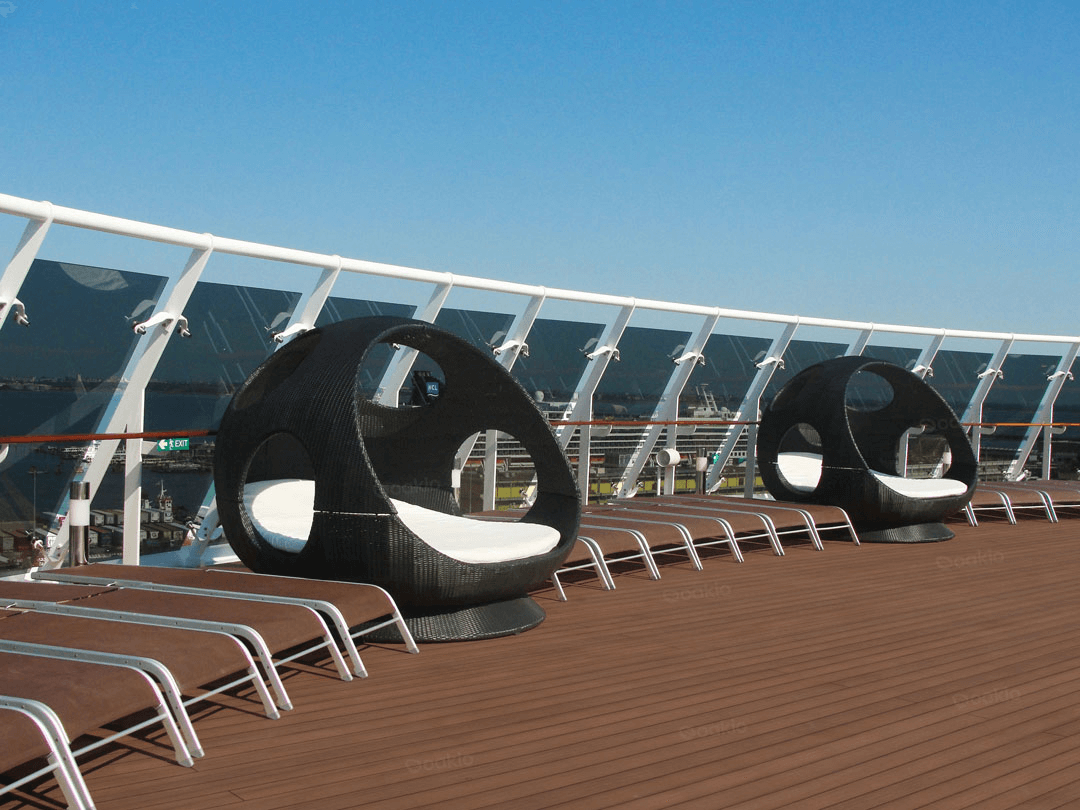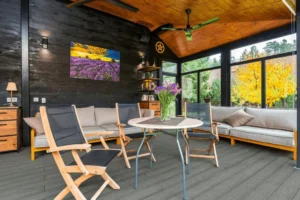Composite Deck Structure: What Are The Parts Of A Deck?
Composite decks have been around for quite some time, and they’re getting noticed much more these days, thanks to how they revolutionized and optimized outdoor spaces to be places of relaxation and fun.
Some people know composite decks like the back of their hands, especially if they have one on their properties. But if you’re unfamiliar with this type of deck, you might wonder what are the parts of a deck structure and how it differs from the traditional ones.
In this guide, we’ll explore every bit, part, and mechanism of a full composite deck structure and share with you an expert and enthusiast level of knowledge about composite deck systems. Read on!
Composite Deck Structure: Anatomy of a Composite Deck
A composite deck structure typically consists of multiple different parts. But for better understanding, let’s tackle the most important parts before we delve into the smaller and more complex ones.
Composite decks have composite decking boards—which are one of the most essential parts, joists (which are parts of the support structure), railing (so you don’t fall over), beams (which support the joists horizontally), support posts (to support the weight of the deck).
Aside from those, there are also fascia boards (which make your deck look presentable and protected) and fasteners, which clip the composite boards together to form a uniform appearance.
Deck Foundation
A deck’s foundation is one of the crucial parts of deck construction; without it, your deck would be unsafe and crumble under the weight of other deck parts and the occupants. Four parts make up your deck’s foundation:
Footing
Footings are commonly made up of concrete and make up the base of the foundation. Their role is to stabilize and support the weight of the whole deck system over the ground to prevent the structure above from sinking or crumbling.
With these in mind, footings must be constructed carefully to ensure the deck’s structural integrity is optimal and not compromised.
Support Posts
The support posts are vertically oriented structures that connect the deck’s beams to the footings. These posts can be made with solid, treated wood or sometimes steel to ensure proper support to the deck and the footings beneath.
Support posts vary in height and spacing depending on the deck’s design and in numbers depending on the height and overall size of the deck. The bigger and taller the deck is, the more support posts are usually needed.
Beams
On the other hand, beams are horizontal posts to which the support posts attach. Beams lie directly beneath the deck boards and support the weight of the joists and the boards. They are usually made of engineered wood to provide stability and support for the entire deck structure.
Beams are also sized and spaced depending on the deck’s construction design; the larger the deck, the thicker and wider the beams are.
Noggins
Noggins, also more commonly known as bridging, are parts of a deck structure installed between the deck joists to add structural support and increase the structure’s overall stability. It’s good to note that joists may twist and warp over time, and noggins prevent these from happening in the future.
Deck Framing

Aside from the foundation of your deck, framing is also important and a non-negotiable if you want to know how to build a deck structure that is structurally sound and long-lasting. The following parts make up a deck’s framing system:
Ledger Board
A ledger board is a wooden horizontal framing part directly attached to the house and supports the other side of the deck without footings and support posts.
This board is bolted directly to your house’s internal framing system to support the joists and noggins. Installing a ledger board should be done meticulously to prevent damaging the deck and your home’s framing.
Hardware
Yes, you’ve read that right. This hardware part refers to multiple metal structural elements that hold everything together. Hardware includes screws, joist hangers, anchors, bolts, nails, and other small pieces of metal that go along your deck to make sure it’s durable and stable.
Hardware should be rust-resistant to ensure the deck’s longevity and provide lasting stability and structural support.
Joists
Joists are horizontally oriented wooden substructures (found beneath the deck, supporting its weight) that span along the support beams and act as the primary framing for the deck.
Just like other parts of a deck structure, joists are sized and spaced depending on the design requirements of the deck. The bigger and wider the deck is, the thicker and more numerous the joists are.
Blocking and Bridging
Blocking and bridging are wooden lateral parts of the substructure that provide additional support to the joists to prevent twisting and sagging in the long run. These are short pieces of wood that are attached to the joists using bolts or screws, which increases the stability of the joists and the entire frame of the deck.
Deck Surface
The deck surface is made up of three different parts with different functions and purposes:
Decking Boards
Decking boards are the “cherries” on your deck in the sense that they’re the primary material to make up the deck. Without them, your deck would be just a frame with no purpose.

Typically, decking boards are made with traditional wood, but composite decking boards are making rounds worldwide as a long-lasting and low-maintenance decking solution. Deck board installation should be optimal to ensure overall deck longevity.
Fasteners
Fasteners are a type of hardware that is used to attach the boards to the joists and bridging. A fastener can be a simple rust-resistant screw or nail or hidden stainless steel clips that ensure a uniform and presentable look.
Fasteners must be installed optimally to ensure the boards are cohesive and stable as people walk over the deck.
Drainage
An important part of a deck to ensure a long-lasting deck structure is a drainage system, which is included in a deck’s installation to ensure water doesn’t pool in the decks and cause considerable damage, especially for traditional wooden decks.
An example of a simple decking drainage system is to ensure sufficient spacing between the deck boards to let water flow beneath or to add a sloping design to direct water away from the deck boards.
Deck Finishing Touches
Aside from the fundamental parts of a deck structure, some parts are usually installed for cosmetic and aesthetic reasons and additional support and safety for the deck.
Railings
For deck railings, there are four distinct parts: the top rail, balustrades, the bottom rail, and newels:
Top Rail
The top rail is a horizontal part of a railing system that runs along the very top of the rail. This rail provides a handhold to provide safety and stability for deck occupants. Top rails may be thicker than other parts of the rail as they need to provide a comfortable handhold.
Balustrades
Balustrades are vertical posts that support the weight of the top rail, which creates a physical barrier around the edge of the deck for safety purposes. Aside from the safety it provides, balustrades also serve an aesthetic purpose.
Bottom Rail
A bottom rail runs beneath the balustrades, also providing added support for the balustrades and, consequently, the top rail. Since balustrades are the main physical barrier for the rails, a bottom rail must be installed carefully to ensure excellent overall railing stability.
Newel
Newels are thick posts placed strategically along the railing system to provide primary structural support and deck anchoring points. A newel is the primary anchoring system that attaches the entire railing system to the deck and is the main structure that resists movement along the rails.
Stairs
If a deck is elevated, it needs a set of stairs for better accessibility. Here are three parts of a deck stair system on a composite deck structure:
Treads
The treads are the horizontal planks of wood or composite that form the steps of the stairs. These must be perfectly flat and free from splinters or other obstacles to provide a stable platform for walking up and down. At times, treads are made of specialized non-slip material to enhance safety for users.
Risers
Risers are vertical components that close the space between and beneath each tread to prevent tripping and falling hazards. These are usually made of sturdy wood planks and are colored brighter than the treads to enhance visibility.
Stringers
Stringers are support parts that run diagonally beneath the stairs, connecting the treads and risers to ensure stability and enhance the stair’s overall load-bearing capacity. Stringers resemble fascia boards because they both enhance the structure and improve aesthetics.
Additional Features
There are also added features in a deck—they can be purely cosmetic in purpose, but some enhance the deck’s usability and protect it against numerous damaging elements, such as water and snow.
Skirts
Skirts are wood or composite panels that act as visual barriers for your decks. They hide the unsightly frame beneath your deck, such as the joists and fasteners, and protect from the elements, such as rain and snow.
Benches
Benches are seating elements that can be integrated into your deck’s design and construction. A bench may be freestanding (you can buy one in a furniture store) or a built-in one that comes with your deck kit if you opt for a composite decking system.
Start Your Decking Project with Oakio Today!
All in all, a composite deck structure has numerous parts, all with unique features and purposes. And to make things easier, did you know that building a composite deck is quicker and easier than other decking types? Now that you know the parts of a composite deck, maybe it’s time to start your decking project with Oakio!
With that in mind, what if you imagine your property with a composite deck right now? Can you visualize it? If not, our product visualizer tool will do it for you! And if you want to factor in every bit of possible costs, you may want to check out our decking calculator for accurate computations!
At Oakio, we’re committed to serving your decking needs with our expertise backed by our reputation as a leading composite wood manufacturer, innovator, and producer. All you need to do to start your composite deck journey is contact and partner with us with your project!
Want to read more blogs like these? Consider subscribing to our newsletter today and be in the know with our latest blog uploads, and be the first to avail our exclusive deals and discounts!
Trending Reading
What Are the Differences Between the WPC Board and PVC Board?
[2024 Update] How Long Does WPC Decking Last?













